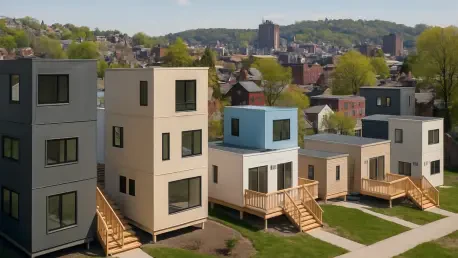In the heart of Pittsburgh, a pressing challenge looms over the housing market as the gap between affordable options for low-income residents and luxury developments for the affluent continues to widen, leaving middle-income earners struggling to find suitable homes. This disparity has sparked innovative responses, with a groundbreaking project at Hazelwood Green emerging as a potential game-changer. Spearheaded by a local manufacturing startup, Module, the city’s first modular multi-family apartment building, known as Eliza Street Housing, aims to address this “missing middle” by offering a scalable, cost-effective solution. With construction timelines slashed through prefabricated techniques, this 30-unit, three-story walk-up is designed specifically for middle-income renters. As urban areas grapple with housing shortages, the question arises whether such modular approaches can truly bridge the divide and provide a sustainable model for communities in need of balanced development.
Revolutionizing Construction with Modular Techniques
A significant advantage of the Eliza Street Housing project lies in its use of modular construction, a method that promises to transform traditional building timelines and costs. By fabricating components such as framing, drywall, and fixtures in a factory setting in Carnegie, the project reduces the typical 14-16 month construction period to just around 12 months. This efficiency stems from the ability to work on site preparations simultaneously with off-site assembly, culminating in the transportation and stacking of units with a crane for final touches like roofing. Such an approach not only accelerates delivery but also minimizes disruptions in urban neighborhoods, making it a practical choice for densely populated areas. The potential for scalability in this technique offers hope for addressing housing demands quickly, particularly for those who fall into the middle-income bracket and often find themselves overlooked by conventional development models focused on extremes of the economic spectrum.
Beyond speed, modular construction, as exemplified by this initiative, also brings a notable reduction in financial barriers, enabling smaller developers to participate in the housing market. Unlike larger apartment complexes that require substantial upfront investment, projects like this one demand fewer units and thus lower capital, democratizing access to development opportunities. The design of the building as a pedestrian-scale structure further enhances its appeal, aligning with community needs rather than imposing oversized complexes that can feel disconnected from the local fabric. Additionally, the integration of commercial construction standards, such as fire sprinklers, marks a significant step for Module in tackling multi-family housing, ensuring safety and compliance while maintaining affordability. This blend of innovation and practicality positions modular building as a compelling strategy to fill housing gaps in cities facing similar challenges to Pittsburgh.
Addressing the Missing Middle in Urban Housing
The concept of “middle housing” is central to the vision behind Eliza Street Housing, aiming to provide options that fit between single-family homes and sprawling apartment complexes. This type of development caters directly to middle-income renters who often struggle to find residences that match their financial capacity and lifestyle preferences in urban settings. Brian Gaudio, CEO of Module, emphasizes the cost-effectiveness of such projects, noting that their smaller scale reduces financial risk and makes them viable for developers without extensive resources. Moreover, the design incorporates community-oriented features like a courtyard with walking paths and vibrant landscaping, fostering a sense of belonging among residents. These elements highlight an intentional effort to create spaces that are not just functional but also enriching, addressing both the physical and social needs of those who will call this place home.
Complementing this focus on middle-income housing, the broader development at Hazelwood Green reflects a commitment to diversity in housing solutions. Alongside Eliza Street Housing, another project named Eliza Commons targets low-income residents with support from subsidies like Low-Income Housing Tax Credits. Both initiatives are slated to break ground in the coming year, showcasing a strategic approach to integrating varied income levels within the same neighborhood. This dual focus helps prevent the segregation often seen in urban planning, where economic classes are divided by geography. Module’s prior experience with affordable townhouses in the Hill District further underscores their adaptability in using modular methods across different housing types, suggesting a versatile framework that could inspire other cities to adopt similar tactics in balancing their own housing ecosystems.
A Vision for Sustainable Urban Development
Looking back, the introduction of Eliza Street Housing at Hazelwood Green stood as a pioneering moment in Pittsburgh’s ongoing battle against housing inequity. The adoption of modular construction techniques demonstrated a tangible reduction in build times and costs, setting a precedent for how urban centers could tackle the elusive “missing middle” demographic with efficiency and foresight. The thoughtful integration of community spaces within the design also proved that affordability need not come at the expense of quality or connection, offering a blueprint for future projects. As construction commenced alongside complementary developments like Eliza Commons, the area became a testing ground for inclusive urban planning. Moving forward, stakeholders should prioritize policies that support modular innovation, streamline regulatory approvals, and incentivize mixed-income developments. By scaling these efforts, other cities could replicate this model, ensuring that middle-income residents are no longer sidelined in the quest for equitable housing solutions.









